
Art Gharana — 3 Mins read
Top 10 Easy Songs for Beginners
Vocal
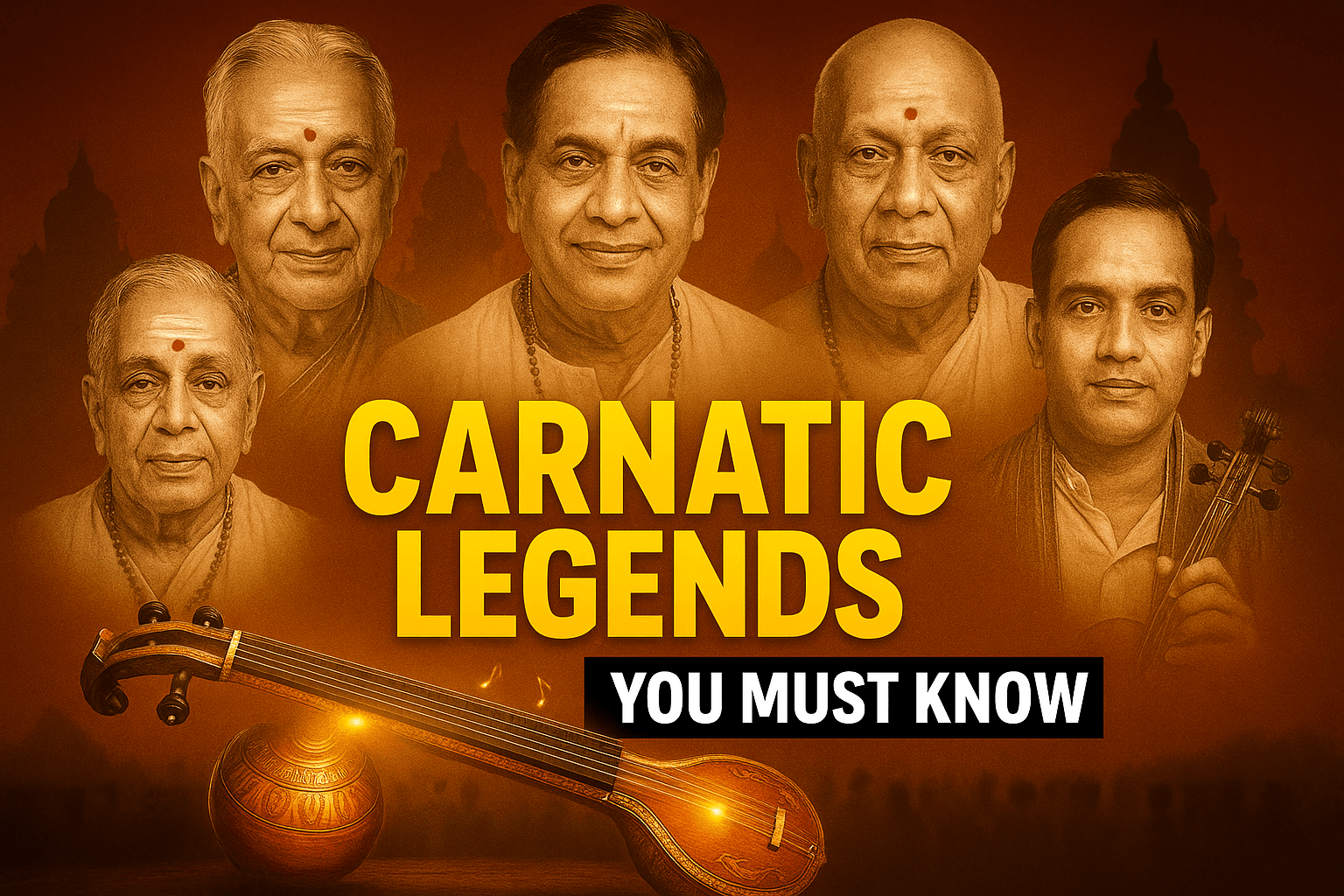 Carnatic music, one of the oldest forms of classical music, has a rich history that spans centuries. Originating from the southern part of India, this vibrant and intricate style of music continues to enchant audiences around the world. If you're interested in exploring the world of Carnatic classical music, it's essential to know the pioneers and maestros who have shaped its evolution. In this article, we'll introduce you to some of the most famous Carnatic musicians you should know.
Carnatic music, one of the oldest forms of classical music, has a rich history that spans centuries. Originating from the southern part of India, this vibrant and intricate style of music continues to enchant audiences around the world. If you're interested in exploring the world of Carnatic classical music, it's essential to know the pioneers and maestros who have shaped its evolution. In this article, we'll introduce you to some of the most famous Carnatic musicians you should know.
 Carnatic music traces its roots to ancient Indian scriptures, particularly the Vedas and the Natya Shastra. It has evolved over time, incorporating elements from various regions and cultures. The primary focus of Carnatic music is vocal, although it also includes instrumental compositions. One of the key features is the use of ragas (melodic frameworks) and talas (rhythmic cycles), which together create a unique and complex sound.
Carnatic music traces its roots to ancient Indian scriptures, particularly the Vedas and the Natya Shastra. It has evolved over time, incorporating elements from various regions and cultures. The primary focus of Carnatic music is vocal, although it also includes instrumental compositions. One of the key features is the use of ragas (melodic frameworks) and talas (rhythmic cycles), which together create a unique and complex sound.
The historical context of Carnatic music is deeply intertwined with the cultural and religious traditions of South India. It is believed that Carnatic music was systematized between the 14th and 16th centuries, a period that witnessed the compilation of numerous texts on music theory. During this time, the Vijayanagara Empire played a crucial role in nurturing and promoting arts, including music. The temples, courts, and assemblies became vibrant centers for musicians to perform and exchange ideas.
Ancient texts, such as the Natya Shastra, laid the foundational principles for Indian classical music, including Carnatic music. The Natya Shastra, written by Bharata Muni, is a comprehensive treatise that covers various art forms, including music, dance, and drama. It describes the construction of musical instruments, the concept of ragas, and the rules for performance. This ancient text continues to influence the practice and teaching of Carnatic music today.
 Temples and royal courts have historically been crucial in the preservation and propagation of Carnatic music. Temples served as both spiritual and cultural hubs where music was an integral part of rituals and festivities. Royal patronage, especially during the reign of the Nayakas and the Marathas, provided musicians with the resources and platforms to develop their art. This patronage helped in creating a rich repository of compositions that are still performed today.
Temples and royal courts have historically been crucial in the preservation and propagation of Carnatic music. Temples served as both spiritual and cultural hubs where music was an integral part of rituals and festivities. Royal patronage, especially during the reign of the Nayakas and the Marathas, provided musicians with the resources and platforms to develop their art. This patronage helped in creating a rich repository of compositions that are still performed today.
Carnatic music has not only retained its traditional roots but has also evolved to embrace global influences. Over the centuries, it has interacted with various musical traditions, incorporating elements that enhance its appeal. Musicians today are experimenting with fusion genres, blending Carnatic music with jazz, blues, and other world music forms, thereby reaching a wider international audience. This evolution signifies the dynamic nature of Carnatic music and its ability to adapt and innovate.
While Carnatic music evolved in South India, its counterpart, Hindustani classical music, shaped the northern traditions. Today, both styles continue to inspire learners, with opportunities to explore Hindustani vocal classes online and experience their unique beauty.
Ragas are the soul of Carnatic music, providing a structured yet flexible framework for compositions and improvisations. Each raga has its own distinct mood and emotion, allowing musicians to convey a wide range of feelings. Talas, on the other hand, are rhythmic patterns that form the backbone of a piece, guiding its tempo and structure.
Ragas in Carnatic music are much more than just scales; they are melodic frameworks that have specific rules and characteristics. Each raga is associated with a particular emotion or mood, known as "rasa," which musicians evoke during performances. The mastery of ragas requires years of practice and understanding of their nuances, as they dictate not only the notes to be played but also the way they are to be rendered.
If you’re inspired to dive deeper into ragas and talas, structured guidance through online Carnatic vocal classes can help you build a strong foundation under expert teachers.
Ragas are deeply tied to the emotional and spiritual aspects of Carnatic music. They are often performed with the intention of invoking certain feelings in the listener, such as joy, devotion, or tranquility. Many ragas are also associated with specific times of the day or seasons, adding another layer of complexity and depth to their performance. This emotional connectivity is what makes ragas a powerful medium of expression in Carnatic music.
Talas are the rhythmic cycles that provide a framework for the timing and tempo of a composition. Each tala has a specific number of beats, which are grouped in a particular pattern. Musicians use hand gestures and vocal syllables to mark the beats and divisions within a tala. The interplay between the melody of the raga and the rhythm of the tala creates the intricate and dynamic sound that is characteristic of Carnatic music.
Improvisation is a cornerstone of Carnatic music, allowing musicians to showcase their creativity within the boundaries set by the raga and tala. During performances, musicians often engage in "manodharma sangeetham," or creative music, where they spontaneously create variations and explore new expressions. This aspect of improvisation keeps the tradition of Carnatic music vibrant and constantly evolving, as each performance is unique and reflective of the artist's personal interpretation.
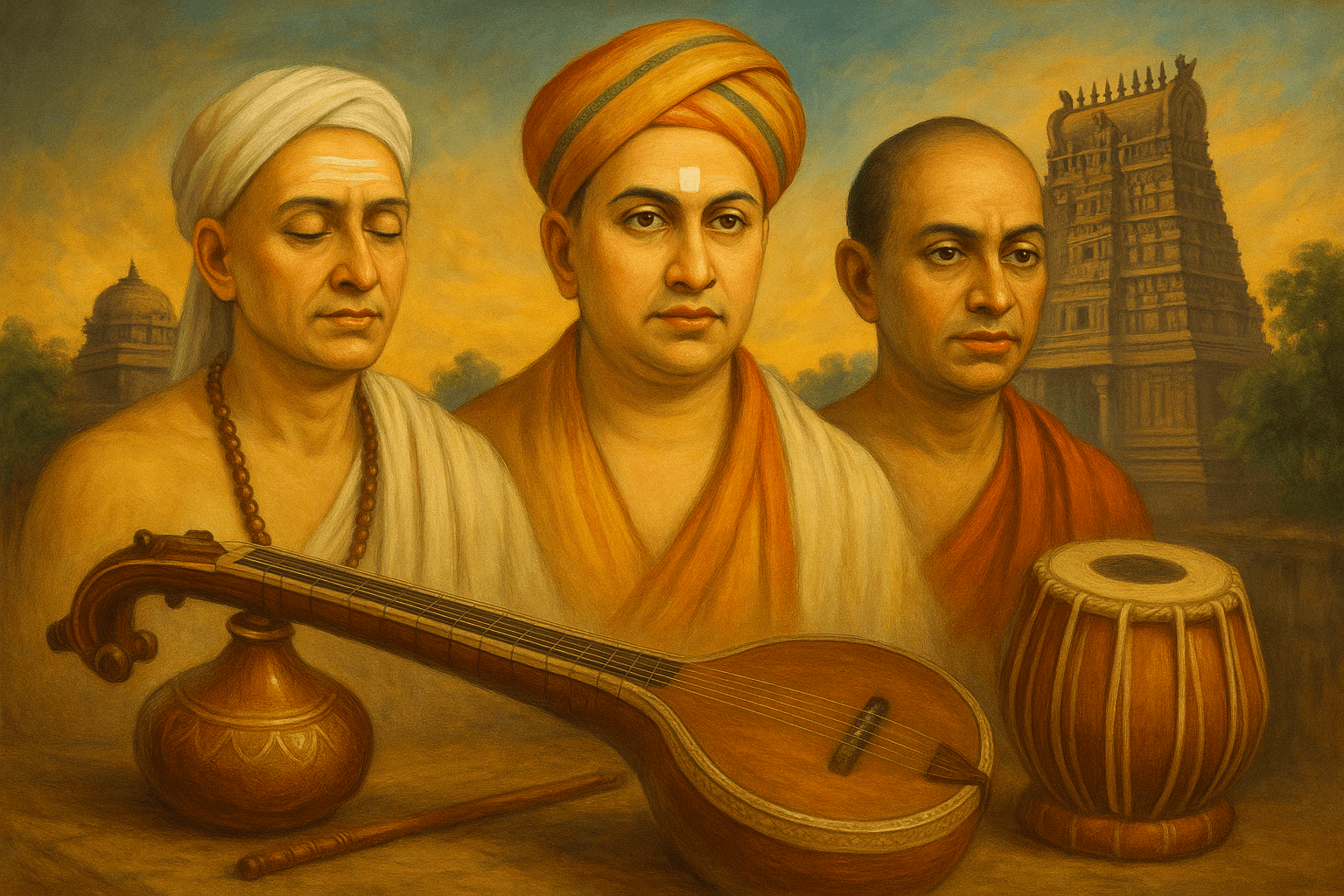 Throughout history, numerous talented artists have contributed to the development and popularization of Carnatic music. Here are some of the most influential musicians you should know.
Throughout history, numerous talented artists have contributed to the development and popularization of Carnatic music. Here are some of the most influential musicians you should know.
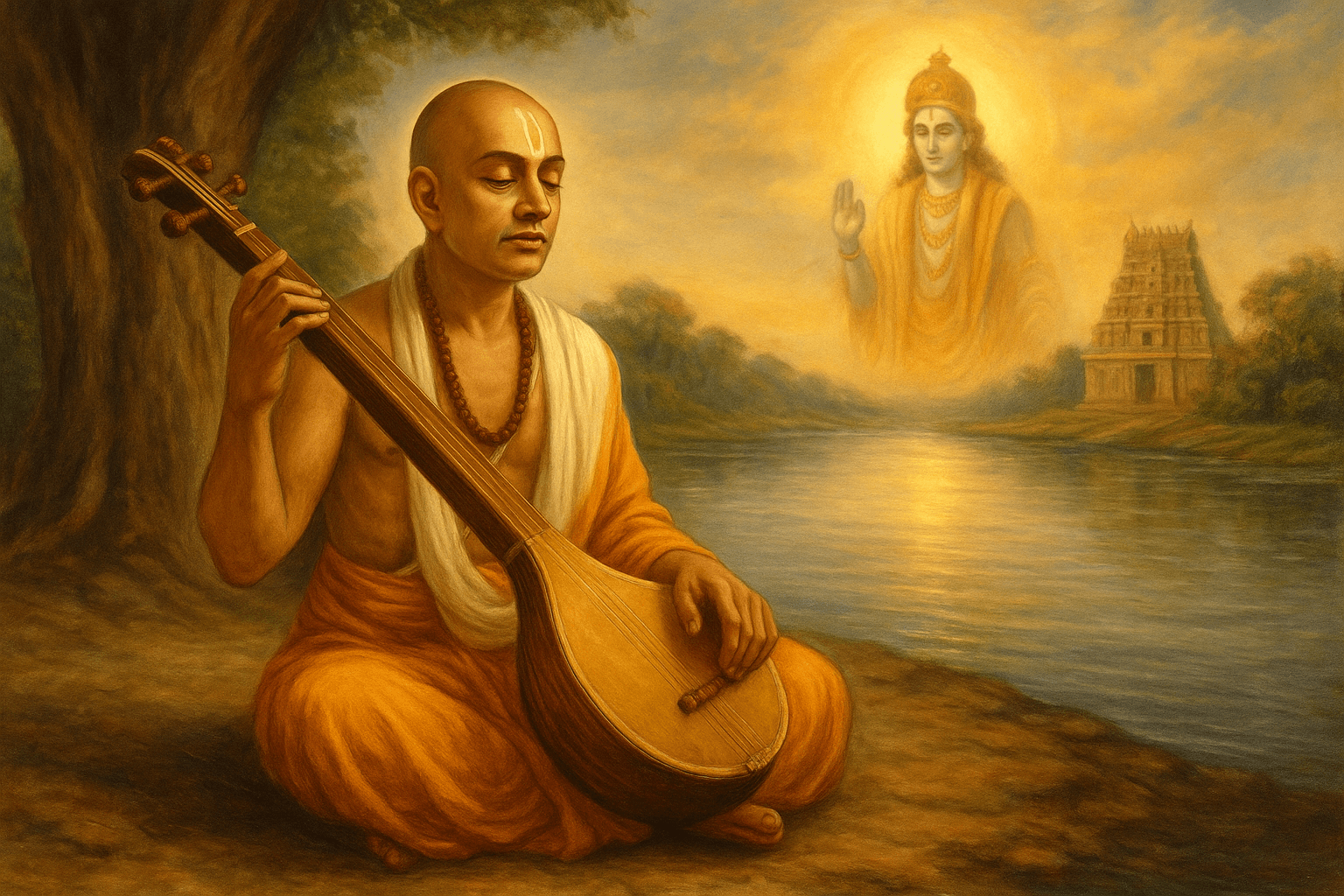 Saint Tyagaraja is one of the most revered figures in Carnatic music. Born in the town of Thiruvaiyaru in Tamil Nadu, he composed thousands of devotional songs, primarily in praise of Lord Rama. His works are characterized by their deep spirituality and intricate melodic structures. Tyagaraja's compositions, known as kritis, remain an integral part of Carnatic concerts today.
Saint Tyagaraja is one of the most revered figures in Carnatic music. Born in the town of Thiruvaiyaru in Tamil Nadu, he composed thousands of devotional songs, primarily in praise of Lord Rama. His works are characterized by their deep spirituality and intricate melodic structures. Tyagaraja's compositions, known as kritis, remain an integral part of Carnatic concerts today.
Tyagaraja's life was one of deep devotion and dedication to music and spirituality. He was born into a Brahmin family, and his early life was steeped in religious practices and musical traditions. His compositions often reflect his unwavering devotion to Lord Rama, with lyrics that express a profound sense of love and surrender. This spiritual element is what makes Tyagaraja's music timeless and revered.
Tyagaraja's compositions are known for their lyrical beauty and melodic richness. He composed in Telugu, a language that allowed him to weave intricate poetic expressions into his music. His kritis are celebrated for their emotive depth and technical complexity, often incorporating a range of ragas and talas. Tyagaraja's innovative use of melody and rhythm set a new standard for Carnatic music that continues to inspire musicians today.
The legacy of Tyagaraja extends beyond his compositions; he is credited with establishing a new era in Carnatic music. His annual music festival, the Tyagaraja Aradhana, held in Thiruvaiyaru, attracts musicians and enthusiasts from around the world. This festival is a testament to his enduring influence and the reverence he commands in the world of Carnatic music. Through his works, Tyagaraja has left an indelible mark on the musical and cultural landscape of India.
Muthuswami Dikshitar was another prominent composer whose contributions to Carnatic music are invaluable. A member of the famous 'Trinity of Carnatic Music' alongside Tyagaraja and Shyama Shastri, Dikshitar's compositions are known for their complexity and beauty. He composed in Sanskrit and incorporated elements of Western music, such as the use of the violin, into his works.
Muthuswami Dikshitar's journey in music is marked by his unique innovations and eclectic influences. Born into a family of scholars and musicians, Dikshitar was exposed to a wide array of musical traditions early in life. His travels across India enriched his understanding and allowed him to integrate diverse elements into his compositions. His innovative use of instruments, such as the violin, set him apart and added a new dimension to Carnatic music.
Dikshitar's compositions are celebrated for their intricate structure and thematic depth. He composed mainly in Sanskrit, using complex lyrical and musical frameworks. His kritis often depict various Hindu deities, rituals, and mythological themes, reflecting his deep knowledge of the scriptures. The inclusion of Western musical elements, such as the violin, demonstrates Dikshitar's openness to experimentation and fusion, which was ahead of his time.
Muthuswami Dikshitar's impact on Carnatic music is profound, with his compositions being an essential part of the repertoire for any serious musician. His kritis are not only performed in concerts but also studied for their technical mastery and aesthetic appeal. Dikshitar's ability to blend tradition with innovation has left a lasting legacy, ensuring his place as one of the most influential figures in the history of Carnatic music.
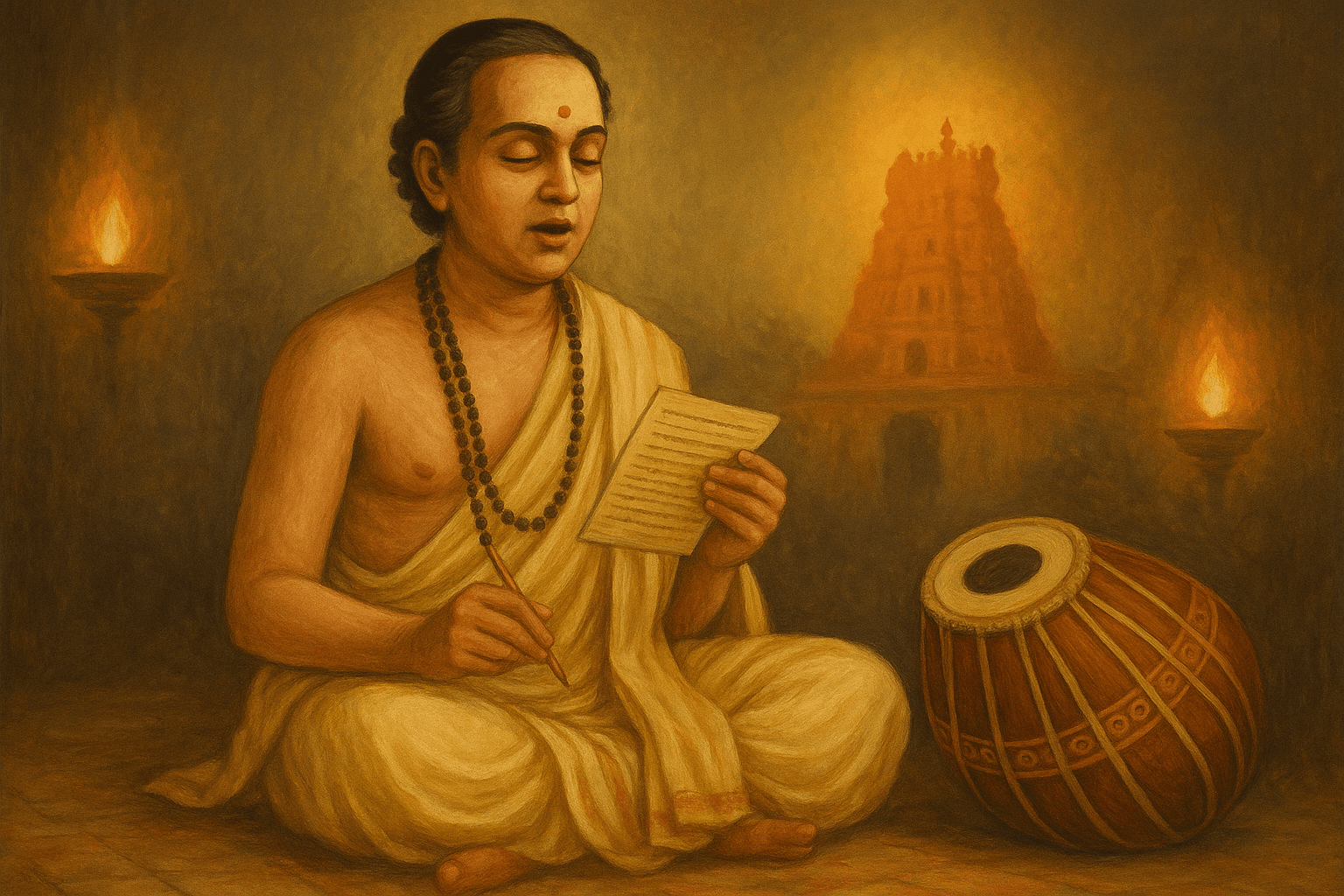 Shyama Shastri, the third member of the Carnatic Trinity, was a prolific composer and musician. Born in Tiruvarur, Tamil Nadu, he created around 300 compositions, primarily in Telugu. His works are known for their intricate rhythmic patterns and deep emotional expression. Shyama Shastri's compositions continue to be performed and cherished by musicians and listeners alike.
Shyama Shastri, the third member of the Carnatic Trinity, was a prolific composer and musician. Born in Tiruvarur, Tamil Nadu, he created around 300 compositions, primarily in Telugu. His works are known for their intricate rhythmic patterns and deep emotional expression. Shyama Shastri's compositions continue to be performed and cherished by musicians and listeners alike.
Shyama Shastri's early life was steeped in the rich musical traditions of his family and community. He was trained in music by his mother and other local musicians, who recognized his prodigious talent. His deep understanding of rhythm and melody was evident from a young age, and his compositions reflect a profound grasp of the technical and emotional aspects of music.
One of the defining features of Shyama Shastri's compositions is their complex rhythmic patterns. He often employed intricate talas, creating compositions that are both challenging and rewarding for musicians to perform. His ability to convey deep emotions through these rhythmic structures is a testament to his genius and his understanding of the expressive power of music.
Shyama Shastri's contributions to Carnatic music extend beyond his compositions. He played a key role in preserving and promoting the musical traditions of his time, ensuring that they were passed down to future generations. His works continue to inspire musicians and are an essential part of the Carnatic music repertoire. Shastri's legacy is one of innovation, devotion, and an unwavering commitment to the art of music.
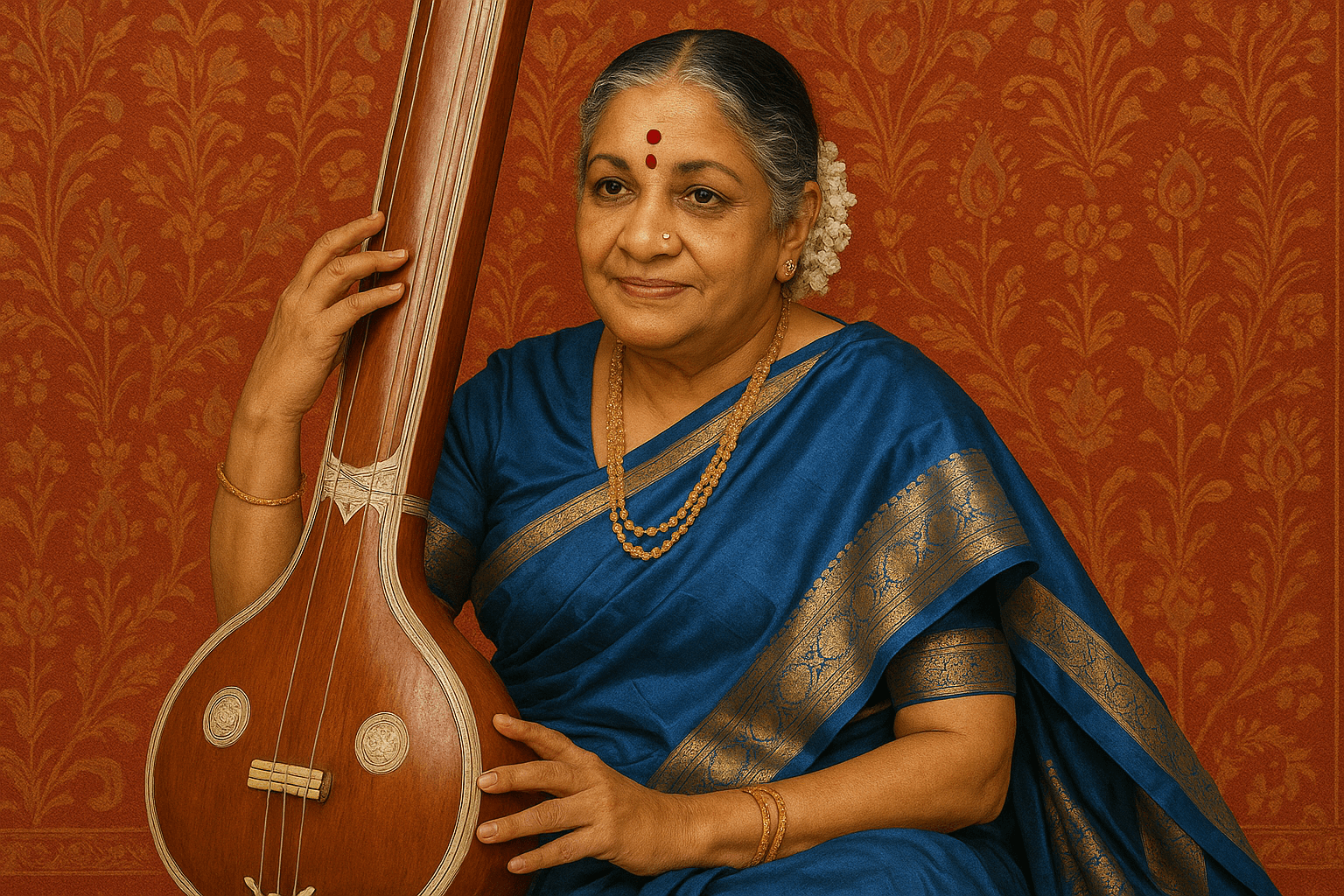 Madurai Shanmukhavadivu Subbulakshmi, better known as MS Subbulakshmi, was a legendary Carnatic vocalist whose fame transcended national boundaries. Born in Madurai, Tamil Nadu, she was the first musician to receive the Bharat Ratna, India's highest civilian award. Her mesmerizing voice and soulful renditions of Carnatic compositions earned her a devoted following across the globe.
Madurai Shanmukhavadivu Subbulakshmi, better known as MS Subbulakshmi, was a legendary Carnatic vocalist whose fame transcended national boundaries. Born in Madurai, Tamil Nadu, she was the first musician to receive the Bharat Ratna, India's highest civilian award. Her mesmerizing voice and soulful renditions of Carnatic compositions earned her a devoted following across the globe.
MS Subbulakshmi's rise to stardom is a story of talent, dedication, and perseverance. Born into a musical family, she was exposed to Carnatic music from a young age. Her exceptional talent was evident early on, and she quickly gained recognition for her powerful voice and emotive performances. Her ability to connect with audiences on an emotional level set her apart and propelled her to national and international fame.
Subbulakshmi's performances and recordings are iconic, capturing the essence of Carnatic music in their purity and depth. Her renditions of classical compositions are celebrated for their technical precision and emotional resonance. She was also a pioneering figure in bringing Carnatic music to a global audience, performing at prestigious venues and festivals around the world. Her recordings continue to inspire and move listeners, cementing her status as a legendary figure in Indian classical music.
MS Subbulakshmi's role as a cultural ambassador for India is one of her most enduring legacies. Through her music, she bridged cultural divides and brought the richness of Carnatic tradition to a wider audience. Her contributions to music and culture were recognized with numerous awards and honors, including the Bharat Ratna. Subbulakshmi's legacy is one of excellence, innovation, and a deep commitment to the art of music.
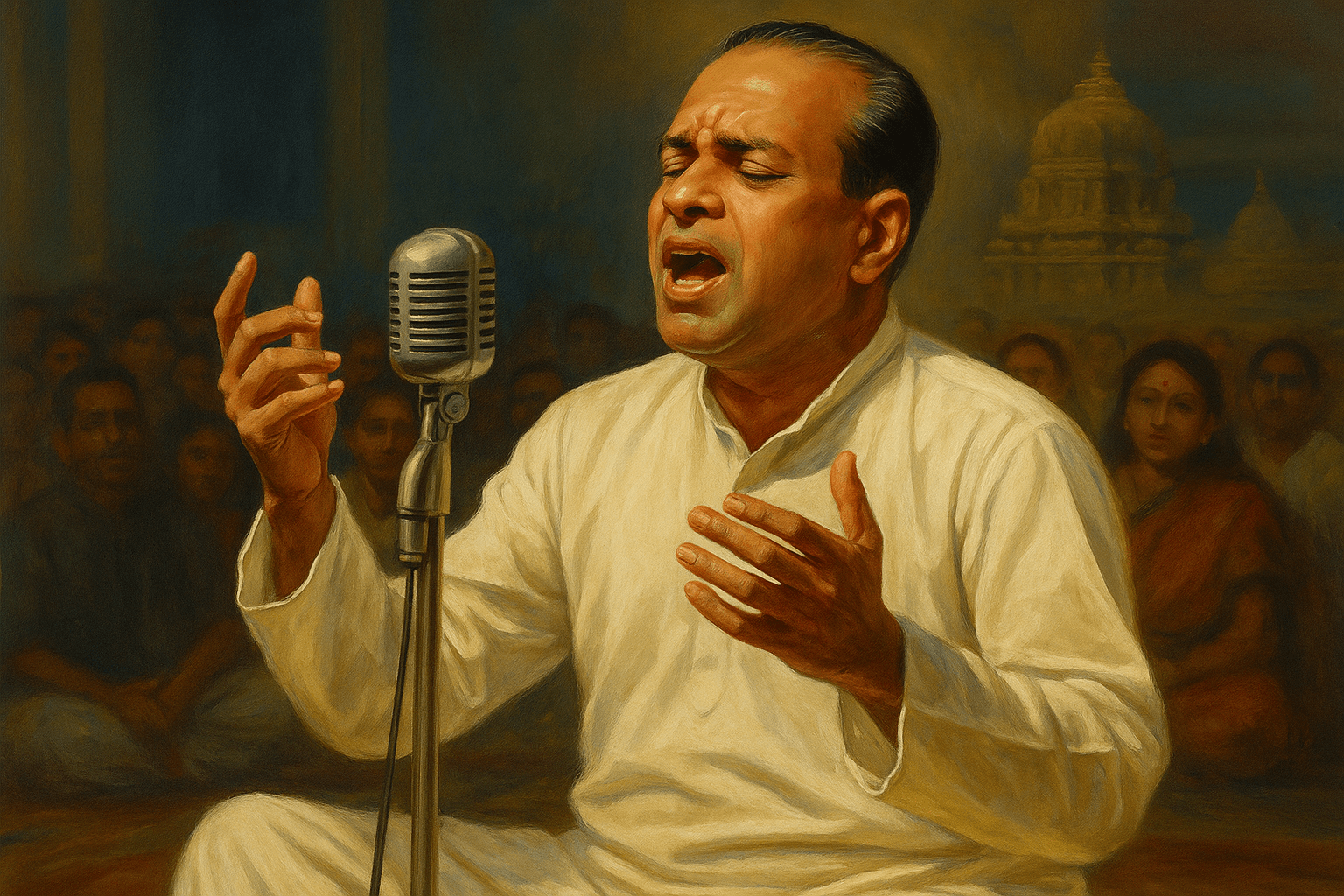 G.N. Balasubramaniam, often referred to as GNB, was a trailblazer in the world of Carnatic music. Known for his exceptional vocal range and innovative style, GNB introduced new techniques and approaches to Carnatic singing. His experimentation with ragas and improvisations set a new standard for future generations of musicians.
G.N. Balasubramaniam, often referred to as GNB, was a trailblazer in the world of Carnatic music. Known for his exceptional vocal range and innovative style, GNB introduced new techniques and approaches to Carnatic singing. His experimentation with ragas and improvisations set a new standard for future generations of musicians.
G.N. Balasubramaniam was an innovator and visionary whose contributions to Carnatic music are unparalleled. His approach to music was marked by a willingness to experiment and push boundaries. He introduced new techniques in vocal music, such as the use of brigas (rapid sequences of notes), which added a new dimension to Carnatic singing. His innovations have had a lasting impact on the style and presentation of Carnatic music.
GNB's vocal techniques and style are characterized by their technical brilliance and emotional depth. He possessed an exceptional vocal range, which allowed him to explore ragas and compositions in new ways. His performances were marked by their dynamic energy and expressive power, captivating audiences and setting new standards for vocal excellence. GNB's style continues to influence singers and remains a benchmark for aspiring musicians.
The legacy of G.N. Balasubramaniam is one of innovation, excellence, and inspiration. His contributions to Carnatic music have influenced generations of musicians, who continue to draw inspiration from his work. GNB's legacy is not only preserved through his recordings and compositions but also through the many students he mentored. His impact on the world of Carnatic music is profound, ensuring that his contributions will be remembered for generations to come.
 Carnatic music continues to thrive today, thanks to the dedication and talent of contemporary musicians who carry forward this rich tradition.
Carnatic music continues to thrive today, thanks to the dedication and talent of contemporary musicians who carry forward this rich tradition.
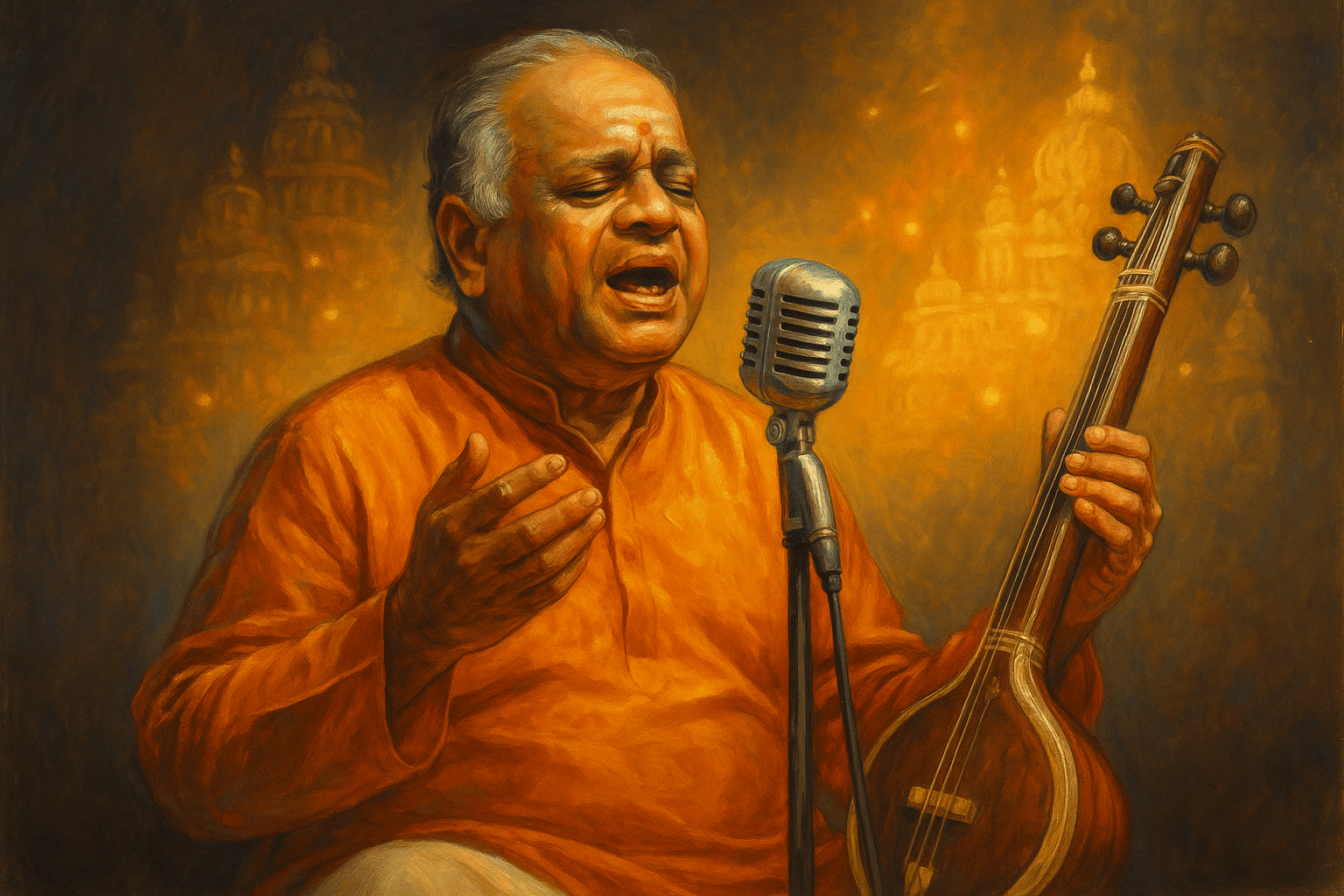 Dr. M. Balamuralikrishna was a versatile musician, composer, and multi-instrumentalist who made significant contributions to Carnatic music. Known for his unique voice and innovative compositions, he created new ragas and talas, expanding the boundaries of the genre. Balamuralikrishna's impact on Carnatic music is profound, inspiring countless musicians around the world.
Dr. M. Balamuralikrishna was a versatile musician, composer, and multi-instrumentalist who made significant contributions to Carnatic music. Known for his unique voice and innovative compositions, he created new ragas and talas, expanding the boundaries of the genre. Balamuralikrishna's impact on Carnatic music is profound, inspiring countless musicians around the world.
Dr. M. Balamuralikrishna was a pioneer in creating new ragas and talas, expanding the repertoire of Carnatic music. His innovative compositions reflect his deep understanding of the art form and his willingness to experiment and explore new possibilities. By introducing new musical concepts, Balamuralikrishna enriched the tradition of Carnatic music and inspired future generations of musicians to embrace creativity and innovation.
Balamuralikrishna's versatility as a musician is evident in his mastery of multiple instruments, including the violin, viola, and mridangam. His exceptional vocal ability and technical skill allowed him to perform complex compositions with ease and grace. His performances were marked by their emotive depth and technical brilliance, captivating audiences and earning him a reputation as a musical genius.
Dr. Balamuralikrishna's influence extends beyond the world of Carnatic music, as he collaborated with musicians from various genres and cultures. His global influence is reflected in his numerous international performances and collaborations, which brought Carnatic music to a wider audience. His contributions to music were recognized with numerous awards and honors, cementing his status as a legendary figure in Indian classical music.
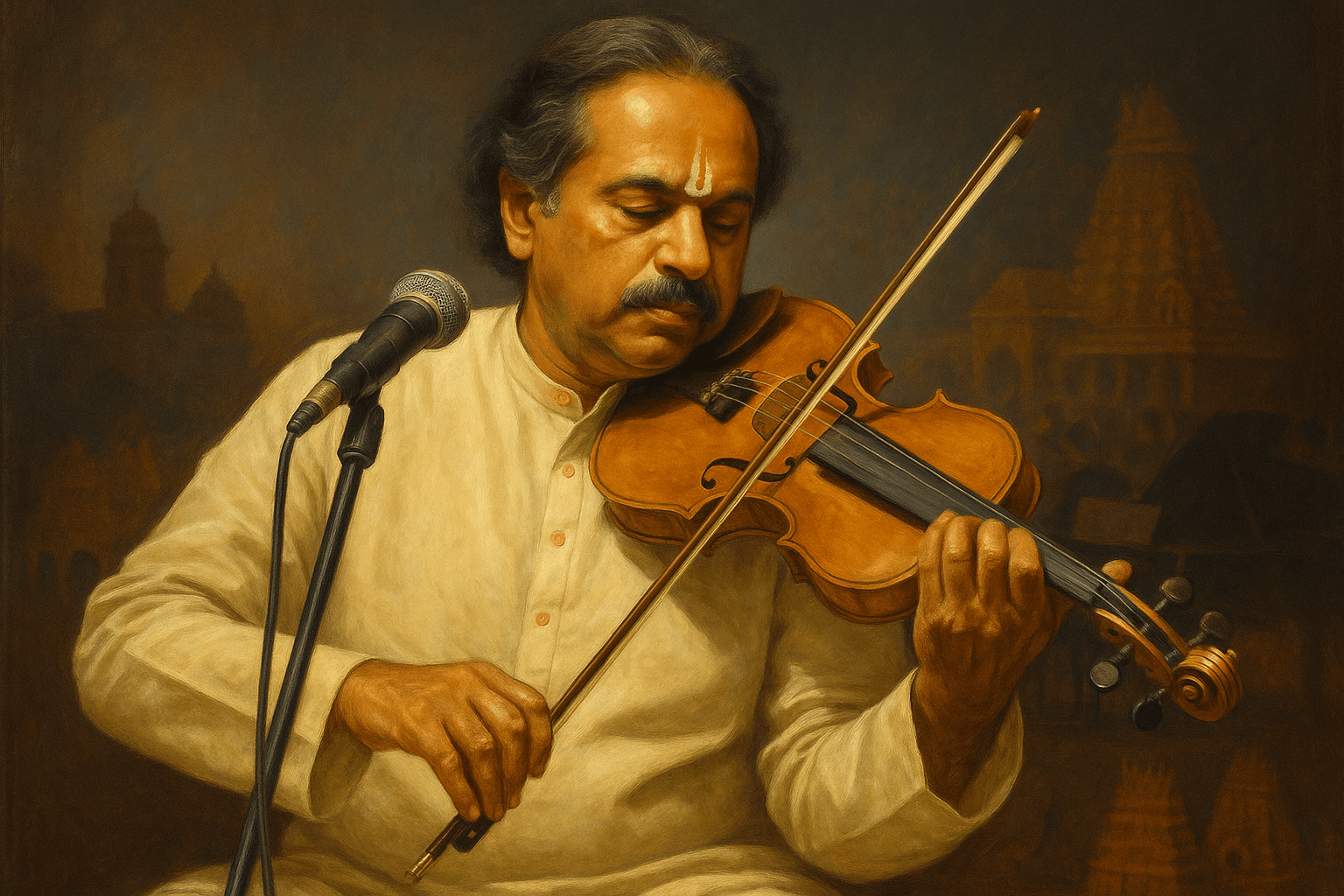 L. Subramaniam is a renowned violinist and composer who has elevated Carnatic music to new heights. Trained in both Carnatic and Western classical music, Subramaniam is known for his virtuosic performances and fusion compositions. He has collaborated with musicians from diverse genres, bringing Carnatic music to a global audience.
L. Subramaniam is a renowned violinist and composer who has elevated Carnatic music to new heights. Trained in both Carnatic and Western classical music, Subramaniam is known for his virtuosic performances and fusion compositions. He has collaborated with musicians from diverse genres, bringing Carnatic music to a global audience.
L. Subramaniam's mastery of the violin is unparalleled, and his virtuosic performances have earned him acclaim from audiences worldwide. Trained in both Carnatic and Western classical music, he possesses a unique ability to blend the two traditions seamlessly. His technical prowess and expressive playing have set new standards for violinists and elevated the status of the violin in Carnatic music.
Subramaniam is a pioneer in the field of musical fusion, bringing together diverse genres and traditions to create new and innovative compositions. His collaborations with jazz, rock, and world music artists have expanded the reach of Carnatic music and introduced it to new audiences. His ability to blend different musical styles while maintaining the integrity of Carnatic tradition is a testament to his creativity and vision.
L. Subramaniam's contributions to global music extend beyond his performances and recordings. He has been an ambassador for Indian classical music, promoting cultural exchange and understanding through his work. His collaborations with international artists have fostered a greater appreciation for the richness and diversity of Carnatic music, ensuring its continued relevance and appeal in the global music landscape.
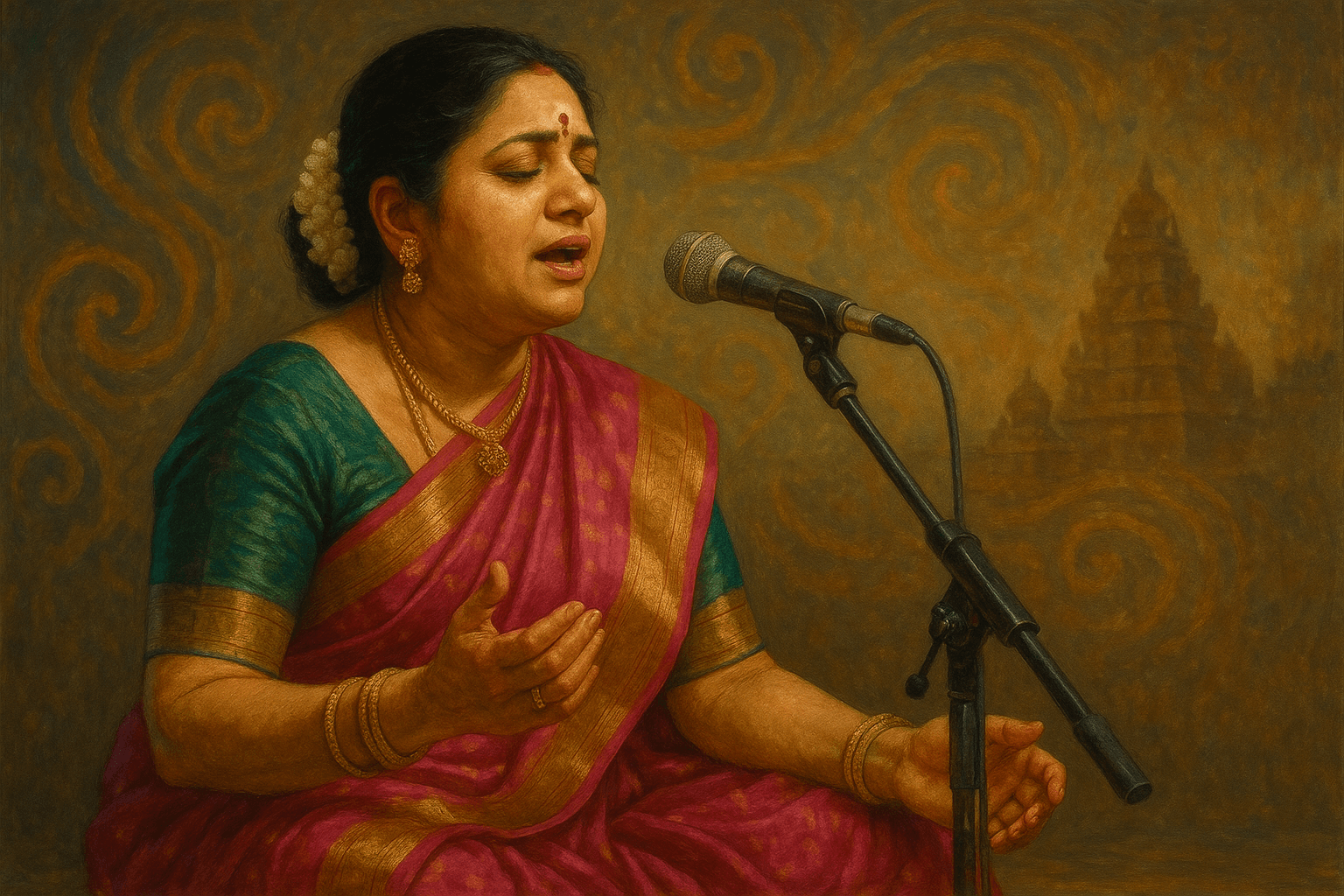 Sudha Ragunathan is a celebrated Carnatic vocalist known for her powerful voice and emotive renditions. A disciple of the legendary M.L. Vasanthakumari, Sudha Ragunathan has performed extensively across India and abroad. Her dedication to preserving and promoting Carnatic music has earned her numerous accolades, including the Padma Bhushan, India's third-highest civilian award.
Sudha Ragunathan is a celebrated Carnatic vocalist known for her powerful voice and emotive renditions. A disciple of the legendary M.L. Vasanthakumari, Sudha Ragunathan has performed extensively across India and abroad. Her dedication to preserving and promoting Carnatic music has earned her numerous accolades, including the Padma Bhushan, India's third-highest civilian award.
Sudha Ragunathan's artistic journey began under the mentorship of M.L. Vasanthakumari, one of the most respected figures in Carnatic music. This training provided her with a strong foundation and a deep understanding of the nuances of Carnatic singing. Her dedication to her craft and her ability to convey deep emotions through her music have earned her a reputation as one of the leading vocalists of her generation.
Ragunathan's performances are characterized by their emotive depth and technical precision. Her powerful voice and ability to connect with audiences on an emotional level have made her a favorite among Carnatic music enthusiasts. Her style reflects a deep respect for tradition while also embracing contemporary influences, making her performances both timeless and relevant.
Beyond her performances, Sudha Ragunathan is a passionate advocate for the promotion and preservation of Carnatic music. She has worked tirelessly to raise awareness of the art form and to ensure its continued relevance in the modern world. Her efforts have been recognized with numerous awards and honors, solidifying her status as a cultural ambassador for Carnatic music and its rich traditions.
As we look to the future, the rich tradition of Carnatic music continues to evolve and adapt. With the rise of digital platforms and global collaborations, Carnatic musicians are finding new ways to share their art with audiences worldwide. This fusion of tradition and innovation ensures that Carnatic music will continue to enchant and inspire generations to come.
The digital age has brought new opportunities for the dissemination and appreciation of Carnatic music. Online platforms and social media have made it easier for musicians to share their work and reach global audiences. Technology has also enabled innovative ways of learning and teaching, with virtual concerts, online tutorials, and digital archives making Carnatic music more accessible to enthusiasts around the world.
The future of Carnatic music is marked by increased global collaborations and fusion with other musical genres. Musicians are experimenting with new sounds and styles, blending traditional Carnatic elements with jazz, blues, and other world music influences. These collaborations not only expand the reach of Carnatic music but also enrich its repertoire, ensuring its continued relevance and appeal in the global music landscape.
Education and preservation are key to the future of Carnatic music, with efforts being made to ensure that the art form is passed down to future generations. Music schools and academies are playing a crucial role in nurturing young talent and providing a strong foundation in the traditions of Carnatic music. Initiatives to document and archive compositions, performances, and musicological studies are also underway, preserving the rich heritage of Carnatic music for future study and appreciation.
Whether you’re a beginner or a music enthusiast, this is the perfect time to book a trial class and experience the magic of Carnatic music firsthand.
The Carnatic music community, including musicians, scholars, and enthusiasts, plays a vital role in the continued growth and evolution of the art form. Community events, festivals, and gatherings provide platforms for musicians to perform, collaborate, and share their knowledge. This sense of community fosters a supportive environment where traditions are honored, innovation is encouraged, and the future of Carnatic music is secured.
In conclusion, the world of Carnatic music is vast and diverse, with a rich history and a promising future. By exploring the works of these famous musicians, you can gain a deeper appreciation for this unique and captivating art form. Whether you're a seasoned aficionado or a curious newcomer, there's always more to discover and enjoy in the world of Carnatic classical music.
With digital platforms making music accessible worldwide, you can now book a free trial class and begin your journey into Carnatic music from the comfort of your home.